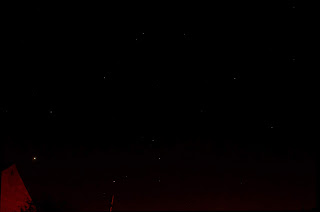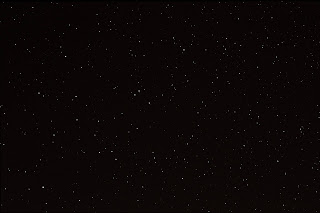May 28th 2230 GMT
I had a quick look outside. There was haze and light cloud everywhere, especially to the north. I bin scanned Jupiter but could not see any moons. I was able to recognise Melotte 111 but saw far less stars than I photographed on 26th. I could just make out the secondary component of Albireo. I also saw Alcor and Mizar, too, but only just. I saw no point in taking a camera out.May 26th 2220 GMT
My original plan was to capture Jupiter's moons but (shock horror!) my remore shutter release had broken, Unwilling to cart my Maksutov out with a bad back, I proceeded straight to Part 2.
The sky was clear but in parts. The north was especially hazy but the south was most clear. I was hoping (very optimistically I must say) to catch a Tau Herculid meteor, while snapping some constellations. I started off badly, with lots of adjustments to the camera settings. I settled on 16mm focal length, ISO 6400 and 8 seconds exposure. Apart from the obvious targets, I tried to photograph Hercules, Serpens Caput and Coma Berenices. While checking, I saw several meteors, including some that appeared to be orbiting in formation and at 2325 GMT, I saw a meteor in Bootes that just might have been a shower meteor but was probably sporadic.
I started with a satellite trail.
Cassiopeia photographed reasonably well, despite the low elevation.
I caught a faint meteor above Lyra. It was probably sporadic.
Then there was a constellation shot of Lyra.
I also caught Bootes and Corona Borealis.
Those of you who follow me will be thinking "oh no, not again!" as you know that Cygnus and Lyra are two of my favourite constellations and this is a great patch of sky. Due to low elevation, the photo only shows the main constellation stars and not the rich Milky Way starfields that I usually capture when they are overhead, later in the year.
Next was Coma Berenices, with Melotte 111 (star cluster) in the bottom right corner.
Not all of Scorpius rises from England but I also caught Libra and Jupiter on camera. The low elevation caused the faint stars and the red glow.
Finally, I processed a few frames to get Serpens Caput.
May 25th 2240 GMT
Conditions were poor, with very few clear patches. Jupiter was low down and shining, so I was hoping to catch its moons.
I caught three.
May 23rd 2215 GMT
I attempted to capture Jupiter's moons with my DSLR at 300mm focal length, ISO 6400 and 2 seconds exposure. Although I caught the moons on several frames, they were all ruined by camera shake. It was a case of waiting for the next opportunity.
May 23rd 2130 GMT
I was not sure when Jupiter was due to rise. I checked the conditions and watched a bright pass of the ISS.
May 20th 2215 GMT
The Moon and Jupiter were low down. I used my DSLR at 300mm focal length. ISO 100 and 1/100 seconds exposure. I then reset the focal length to 70mm and tried different exposures to capture both objects together. I then tried to capture Jupiter with its moons but it looked too cloudy to get a result.
I combined the above image with that of the Moon and Jupiter together but, although I caught Jupiter's moons, it was a very poor image.
May 19th 2305 GMT
Conditions were rather poor, with lots of cloud. I proceeded anyway with a shot of the nearly full moon. Nothing worked.
May 17th 2310 GMT
I did another shot with my DSLR of the Moon with the usual settings,
May 16th 1100 GMT
The sunspot was rotating near the solar limb. I took a photo using the same settings as usual.
I had another go at the Sun in hydrogen alpha light. I had been having difficulties with solar hydrogen alpha light because there had not been many features. As a small feature was there, as I could make out some faculae visually with my PST, I tried some photos, experimenting with camera focussing.
May 15th 2025 GMT
There was time for a quick Moon shot before bedtime. I reduced the exposure time to 1/640 second.
May 15th 1015 GMT
I checked the Sun with my DSLR and filters at my usual settings.
May 14th 2110 GMT
It was a bit hazy but I had a go at the Moon anyway. I used my DSLR at 300mm focal length, ISO 100 and 1/800 second exposure.
May 14th 0550 GMT
The Sun was low, so I increased the exposure time to 1/1600 second when I did my DSLR shot. Unfortunately, I did not detect any sunspots.
May 13th 2105 GMT
It was hazy but the Moon was high in the sky. I took some frames at 300mm focal length, ISO 100 and 1/800 second exposure.
May 13th 1120 GMT
I repeated the solar shoot with my DSLR and filters.
May 13th 2315 GMT
I took some Moon shots with my DSLR and Mak at 1.54m focal length, ISO 100 1/100 seconds exposure. Then I took close-ups at 4.62m with exposures of 1/10 then 1/6 seconds exposure.
May 12th 2115 GMT
I repeated the Moon shot but with ISO setting of 100.
May 12th 1715 GMT
May 12th 1210 GMT
I managed to capture the large sunspot "on film" with my DSLR 300mm focal length, ISO 100 and 1/4000 second exposure. I also used my Baader filter.
May 11th 2210 GMT
The Moon was almost at first quarter and I repeated the shot
from the evening before.
May 11th 1230 GMT
I bin scanned the Sun through a gap in the clouds and noted
that the sunspot had rotated.
May 10th 2230 GMT
May 10th 1000 GMT
Conditions were poor, with lots of moving cloud of various
thicknesses. I bin scanned the Sun but only saw one of the sunspots that I had
seen on the Big Bear and Learmonth observatory images.
May 6th 0940 GMT
I used my DSLR and solar filter to capture the Sun. Focal
length was 300mm, brightness ISO 100 and 1/4000 second exposure.
Unfortunately, my focus was slightly off and I only saw a faint hint of the sunspot on the images.
May 5th 2215 GMT
I had a rather fortunate short session as the weather and forecast had been bad all day. There was cloud and haze, so I decided to do some visuals with my 15x70 binoculars. Obviously, I went straight for the Beehive (M44). It never ceases to amaze me photographically or visually. M35 was lost in the murk (no surprises there either!). Melotte 20 was as badly placed as it gets from the UK but was still a pleasant sight. I was also delighted to see both globular clusters in Hercules: M13 and M92. I tried to catch M29 in Cygnus but haze and distinction stopped it. Thin and thick cloud started to encroach from both east and west, so that was that.
May 4th 2130 GMT
My first image was the Beehive (M44).
I didn't get M35, despite two attempts to aim my camera at it. It expect it to be the last opportunity of the spring, as it was getting really close to the Sun. However, the attempt was not a total waste of time, as I captured some nice star fields in the Milky Way.
Melotte 20 showed well, as usual.
Naturally, I was pleased with Lyra.
I didn't catch M29 but caught a few stars in the area.
There was also a meteor in one of the last set of frames.
May 4th 1640 GMT
There was some clear sky. The Sun looked quiet in hydrogen
alpha light but I had a go anyway with my PST and DSLR.
May 3rd 2300 GMT
I had an unexpected clear spell for a while. Without any
whole constellations on show, I did a shot of Melotte 111 with my DSLR at 70mm,
ISO 6400 and 8 seconds exposure. I managed to get a few frames in before cloud
moved in. Rather than inwardly moaning, I was glad to manage anything at all on
a poor night. I kept half an eye open for Scorpiid and late Lyrid meteors, The
odds were against it and I did not notice any sporadic meteors either.









































No comments:
Post a Comment